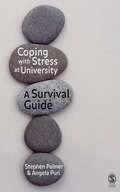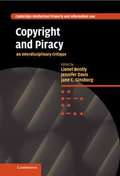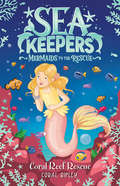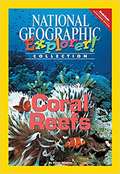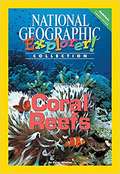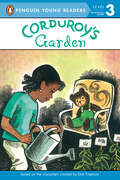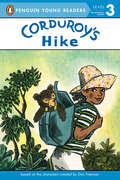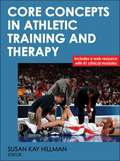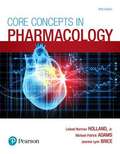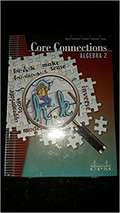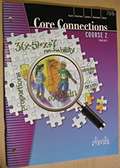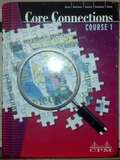- Table View
- List View
Coping in Young Children: Early Intervention Practices to Enhance Adaptive Behavior and Resilience
by Shirley Zeitlin G. Gordon WilliamsonA guide for early intervention professionals describing the ways to assist children with disabilities to integrate and apply their developmental skills for greater flexibility and independent problem solving. Covers application of a theoretical frame of reference, assessment of children's coping styles, and collaborating with parents to facilitate adaptive functioning. Includes case histories and sample forms. Annotation copyright by Book News, Inc. , Portland, OR
Coping with Stress at University: A Survival Guide
by Stephen Palmer Angela PuriCoping with Stress at University comprehensively covers the main problems and stresses that a student may experience during their university career. Looking at university life from a variety of angles, this book equips the student to be able to deal with stressful situations ranging from exam pressure to relationship problems, from homesickness to managing finances. Although the problems do not change, the way a student faces them can and the more effective the approach, the less stress the student will feel when tackling their concerns. Quotes and case studies from previous students illustrate how problems have been dealt with in the past, and a number of coping techniques and exercises are provided to help prepare students for the transition into and through university life. Coping with Stress at University is an invaluable introduction to university life for any potential or current student, and it also acts as a helpful resource for parents and friends wishing to gain a greater understanding of the issues faced at university.
Copyright Law: Essential Cases and Materials
by Joseph P. Liu Alfred C. YenThis casebook emphasizes the essential cases and materials at the heart of copyright law. The result is a streamlined and well-organized casebook of manageable length that keeps the central themes of copyright front and center. It also provides access to a companion Web site containing an extensive library of additional modules, topics, edited cases, notes, problems, and audio-visual materials. Together these materials, along with a companion teacher's manual, allow teachers to easily customize the copyright law course to suit their specific goals. The authors have written extensively about copyright, the arts, and the impact of new technology.
Copyright and Piracy: An Interdisciplinary Critique
by Lionel Bently Jennifer Davis Jane C. GinsburgAn understanding of the changing nature of the law and practice of copyright infringement is a task too big for lawyers alone; it requires additional inputs from economists, historians, technologists, sociologists, cultural theorists and criminologists. Where is the boundary to be drawn between illegal imitation and legal inspiration? Would the answer be different for creators, artists and experts from different disciplines or fields? How have concepts of copyright infringement altered over time and how do such changes relate, if at all, to the cultural norms operating amongst creators in different fields? With such an approach, one might perhaps begin to address the vital and overarching question of whether strong copyright laws, rigorously enforced, impede rather than promote creativity. And what can be done to avoid any such adverse consequences, while maintaining the effectiveness of copyright as an incentive-mechanism for those who need it?
Coral Reef Rescue (Sea Keepers #3)
by Coral RipleyIn this splashy new Sea Keeper tale, something's fishy at a Down Under talent show and the Sea Keepers are called in to help in this third installment in the series.The Sea Keepers are off to Australia to help their mates, the Oceania mermaids! Divers are threatening their beautiful coral reef and evil siren Effluvia has bewitched a dangerous shark to spoil the mermaids' tropical talent show. Now all the fish who live there are in danger! Can Emily, Grace, and Layla find the magical pearl to save the show and protect the reef without becoming a shark's snack?Pick up The Mermaid's Dolphin if you are looking for:The perfect book for 2nd to 5th grade studentsA story with strong female protagonists that explores bravery and friendshipA fun series that promotes environmentalism and other aspects of marine biology
Coral Reefs, Pathfinder Edition (National Geographic Explorer Collection)
by Peter WinklerNIMAC-sourced textbook
Coral Reefs, Pioneer Edition (National Geographic Explorer Collection)
by Peter WinklerNIMAC-sourced textbook
Coral Reefs: A Journey Through an Aquatic World Full of Wonder (Into Reading, Trade Book #6)
by Jason ChinNIMAC-sourced textbook
Corderito tiene hambre (¡Arriba la Lectura!, Level C #41)
by Annette Smith Samantha AsriNIMAC-sourced textbook. José y Lily ven un corderito en la granja. ¿Quieres saber por qué el corderito está contento?
Corduroy's Garden (Corduroy)
by Don Freeman Alison InchesIn Corduroy's Garden, Lisa leaves Corduroy to keep watch over her newly planted seeds. But when a puppy digs up the garden, it's up to Corduroy to save the day.Based on the popular characters created by Don Freeman, the Corduroy easy-to-read series is ideal for children just beginning to read on their own. The brief sentences, repetitive phrases, and important visual clues within the illustrations help readers along while keeping them entertained.
Corduroy's Hike (Corduroy)
by Don Freeman Alison InchesCorduroy was first introduced to readers by Don Freeman in 1968 and has become a contemporary classic. Now everybody's favorite department store bear comes to you in a brand new series aimed at beginning readers.In Corduroy's Hike, Lisa is going on a hike and Corduroy decides that he would like to go too. But then Corduroy falls out of her backpack. Can he find Lisa before she goes home?
Core Concepts in Athletic Training and Therapy
by Susan Kay HillmanCore Concepts in Athletic Training and Therapy provides a balanced introduction to the knowledge, skills, and clinical abilities that span the profession of athletic training. Students in athletic training, coaching, or other health care fields will find current information covering the breadth of theory and application of athletic training, including evidence-based practice, prevention and health promotion, clinical examination and diagnosis, acute and emergency care, therapeutic interventions, and health care administration. It also presents advanced topics of pathophysiology and psychological response to sport injury to better prepare students for continued study. Compared to other introductory athletic training texts, Core Concepts in Athletic Training and Therapy is the only text that aligns with the newest athletic training education competencies from the National Athletic Trainers' Association (2011). Written by a team of respected athletic training educators with experience at the professional and collegiate levels, the text breaks new ground by condensing key concepts to a comprehensive level while not overwhelming students with content that will be addressed in depth in advanced courses. Numerous features assist students in learning the fundamentals: - Each of the six parts opens with a discussion of the competencies that are covered in that part and concludes with a reference list of those competencies by description and number, making it easy to monitor the knowledge required. - A companion web resource contains 41 clinical proficiency exercises, carefully chosen to complement the introductory level of the text and align with required educational objectives. The modules may be completed online or printed, and cross-references at the end of each chapter guide students to the appropriate modules to apply the chapter content. - Case studies sprinkled throughout the text demonstrate real-world situations and include critical thinking questions that underscore principles of rehabilitation and exercise. - Full-color photographs depict specific conditions and techniques, giving students an accurate picture of real practice. - For instructors, a complete set of ancillaries assists in preparing and presenting lectures, leading class discussion, and planning assignments and assessments. In addition, Core Concepts in Athletic Training and Therapy is the first text to offer a complete chapter on evidence-based practice, the newest educational competency required of entry-level athletic trainers by the NATA. The rest of the text introduces general information about life as an athletic trainer, such as training, education, licensure, certification, employment opportunities, and the roles in a sports medicine team. The core of the text then focuses on required knowledge and skills related to injury prevention, injury recognition and classification (including region-specific examination strategies, basic objective tests, physical exam strategies, and injury mechanisms), acute care, therapeutic interventions, and the role of pharmaceuticals in the healing process. To round out the text, it addresses health care administration and discusses strategies for the management of athletic training programs. With learning features and a web resource that integrate clinical learning into an introductory course, Core Concepts in Athletic Training and Therapy is the essential resource for current and future athletic trainers. Long after its first use, it will prove a valuable reference for athletic training students as they progress through the curriculum, prepare for certificiation, and begin careers in the profession. Core Concepts in Athletic Training and Therapy is part of Human Kinetics' Athletic Training Education Series. Featuring the work of respected authorities in athletic training, this collection of outstanding te
Core Concepts in Pharmacology, 5th Edition
by Leland Norman Holland Michael Patrick Adams Jeanine BriceAn interdisciplinary exploration of pharmacology. <P><P>By its very nature, pharmacology is a challenging interdisciplinary subject that requires understanding concepts from a wide variety of the natural and applied sciences to predict drug action. For this reason, authors Holland, Adams, and Brice have organized Core Concepts in Pharmacology according to body systems and diseases, placing drugs in the context of their therapeutic use. This gives students easier access to the prerequisite anatomy, physiology, pathophysiology, and pharmacology organized in the same chapter where the drugs are discussed. <P><P>The Fifth Edition continues its prototype approach of introducing, in detail, the one or two most representative drugs in each class. It also maintains a strong emphasis on safe, effective nursing care with a new chapter on preventing medication errors, features new Drug Focus boxes to cover emerging drugs, and includes many more new and updated features.
Core Connections Algebra 2, Version 4.0
by Kevin Coffey Judy Kysh Michael KassarjianNIMAC-sourced textbook
Core Connections Algebra, Version 5.0
by Leslie Dietiker Kevin Coffey Michael KassarjianNIMAC-sourced textbook
Core Connections Course 2 Version 5
by Leslie Dietiker Evra Baldinger Michael Kassarjian Barbara ShreveCore Connections Course 2
Core Connections Geometry, Version 5.0
by Leslie Dietiker Kevin Coffey Michael KassarjianNIMAC-sourced textbook
Core Connections Integrated I, Version 6.0
by Leslie Dietiker Michael KassarjianNIMAC-sourced textbook
Core Connections Integrated II, Version 6.0
by Leslie Dietiker Michael KassarjianNIMAC-sourced textbook
Core Connections Integrated III, Version 5.0
by Judy Kysh Michael Kassarjian Karen WoottonNIMAC-sourced textbook
Core Connections, Course 1, Second Edition, Volume 1
by CpmIn this course, you will learn to use new models and methods to think about problems as well as solve them. You will develop powerful mathematical tools and learn new ways of thinking about and how to investigate situations. You will learn to make connections, discovering relationships, figuring out what strategies can be used to solve problems, and explaining your thinking. This is volume 1.
Core Connections, Course 1, Second Edition, Volume 2
by CpmIn this course, you will learn to use new models and methods to think about problems as well as solve them. You will develop powerful mathematical tools and learn new ways of thinking about and investigating situations. You will learn how to make connections, discovering relationships, figuring out what strategies can be used to solve problems, and explaining your thinking. This is the second volume.
Core Connections, Course 1, Version 5.0
by Leslie Dietiker Kevin Coffey Michael Kassarjian Misty NikulaNIMAC-sourced textbook

